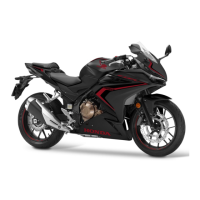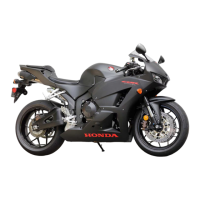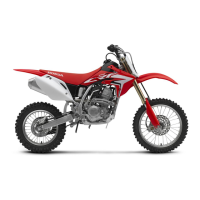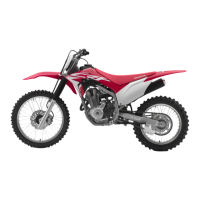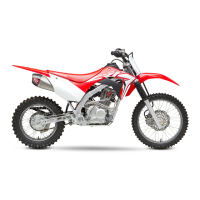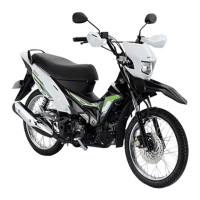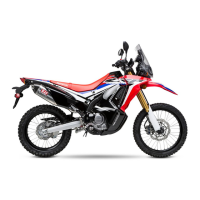Do you have a question about the Honda CB150R 2020 and is the answer not in the manual?
General recommendations for safe riding and vehicle operation.
Explanation of warning and information labels found on the vehicle.
Essential precautions for safe operation, including protective apparel.
Guidelines for safe riding, covering braking, conditions, and parking.
Advice on adding accessories and making modifications to the vehicle.
Instructions on how to properly load luggage and cargo onto the vehicle.
Information about the tachometer, its red zone, and usage notices.
Details on the odometer, tripmeters, and stopwatch functionality.
How to adjust clock, backlight, and REV indicator settings.
Explains the ABS indicator light and its behavior.
Describes the PGM-FI malfunction indicator lamp (MIL).
Information on the high coolant temperature warning light.
Covers REV, Neutral, Turn Signal, High Beam, and Low Fuel indicators.
Controls for headlights, horn, and turn signals.
Function of the ignition switch for starting and locking.
Operation of the engine stop switch for emergencies.
How to lock and unlock the steering for security.
Step-by-step guide to start the engine correctly.
Troubleshooting steps if the engine fails to start.
Lists recommended maintenance intervals and tasks.
General principles and procedures for vehicle maintenance.
Inspection of tyre condition, pressure, and tread depth.
How to check and add engine oil to the vehicle.
Instructions for checking and adding coolant.
Procedures for checking brake fluid and pads.
How to inspect and lubricate the drive chain.
Checking and adjusting clutch lever freeplay.
How to check throttle operation and freeplay.
Steps to diagnose and resolve engine starting issues.
What to do if the high coolant temperature indicator is on.
Explains PGM-FI, ABS, and other warning indicator lights.
Emergency repair procedures for tyre punctures.
Addresses issues like dead battery and burnt-out bulbs.
How to locate, inspect, and replace blown fuses.
Information about ignition keys, key tags, and key duplication.
Guidelines for washing, polishing, and maintaining the vehicle's appearance.
Instructions for storing the vehicle for extended periods.
Proper methods for transporting the motorcycle.
Key physical dimensions and weight specifications of the vehicle.
Technical data including tyre sizes, pressures, fluids, and spark plugs.
Specifications for vehicle bulbs and fuse ratings.
Recommended torque values for various bolts and fasteners.
General recommendations for safe riding and vehicle operation.
Explanation of warning and information labels found on the vehicle.
Essential precautions for safe operation, including protective apparel.
Guidelines for safe riding, covering braking, conditions, and parking.
Advice on adding accessories and making modifications to the vehicle.
Instructions on how to properly load luggage and cargo onto the vehicle.
Information about the tachometer, its red zone, and usage notices.
Details on the odometer, tripmeters, and stopwatch functionality.
How to adjust clock, backlight, and REV indicator settings.
Explains the ABS indicator light and its behavior.
Describes the PGM-FI malfunction indicator lamp (MIL).
Information on the high coolant temperature warning light.
Covers REV, Neutral, Turn Signal, High Beam, and Low Fuel indicators.
Controls for headlights, horn, and turn signals.
Function of the ignition switch for starting and locking.
Operation of the engine stop switch for emergencies.
How to lock and unlock the steering for security.
Step-by-step guide to start the engine correctly.
Troubleshooting steps if the engine fails to start.
Lists recommended maintenance intervals and tasks.
General principles and procedures for vehicle maintenance.
Inspection of tyre condition, pressure, and tread depth.
How to check and add engine oil to the vehicle.
Instructions for checking and adding coolant.
Procedures for checking brake fluid and pads.
How to inspect and lubricate the drive chain.
Checking and adjusting clutch lever freeplay.
How to check throttle operation and freeplay.
Steps to diagnose and resolve engine starting issues.
What to do if the high coolant temperature indicator is on.
Explains PGM-FI, ABS, and other warning indicator lights.
Emergency repair procedures for tyre punctures.
Addresses issues like dead battery and burnt-out bulbs.
How to locate, inspect, and replace blown fuses.
Information about ignition keys, key tags, and key duplication.
Guidelines for washing, polishing, and maintaining the vehicle's appearance.
Instructions for storing the vehicle for extended periods.
Proper methods for transporting the motorcycle.
Key physical dimensions and weight specifications of the vehicle.
Technical data including tyre sizes, pressures, fluids, and spark plugs.
Specifications for vehicle bulbs and fuse ratings.
Recommended torque values for various bolts and fasteners.
| Engine Type | Liquid-cooled, 4-stroke, DOHC, single cylinder |
|---|---|
| Displacement | 149.16 cc |
| Bore x Stroke | 57.3 mm x 57.8 mm |
| Compression Ratio | 11.3:1 |
| Fuel System | PGM-FI (Programmed Fuel Injection) |
| Ignition System | Full Transistorized Ignition |
| Starter System | Electric |
| Transmission | 6-Speed |
| Final Drive | Chain |
| Front Suspension | 41 mm Inverted Telescopic Fork |
| Rear Suspension | Monoshock |
| Wheelbase | 1, 296 mm |
| Seat Height | 795 mm |
| Fuel Tank Capacity | 8.5 liters |
| Frame Type | Diamond |
| Front Brake | Hydraulic Disc |
| Rear Brake | Hydraulic Disc |
| Front Tire | 110/70-17M/C 54H |
| Rear Tire | 150/60-17M/C 66H |

